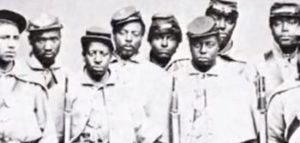
*The 5th United States Colored Cavalry (5th USCC) was formed on this date in 1864. They were a regiment of the United States Colored Troops during the American Civil War.
They were one of the more notable black fighting units. It was officially organized in Kentucky after its first two battles. Colonel James Brisbin commanded it until February 1865, when he took over the 6th US Colored Cavalry. His executive officer, Louis Henry Carpenter, commanded the regiment until 20 March 1866. In the early months of 1864, General Order No. 24 was issued. This authorized the formation of colored units. They were composed of ex-slaves, freedmen, and slaves who had escaped to Union lines.
On January 23, 1865, 80 colored troops of Company E, 5th US Colored Cavalry, under the command of 2nd Lieutenant Augustus Flint, were assigned to move almost a thousand head of cattle from Camp Nelson to the stockyard at Louisville, Kentucky. The men were mainly assigned to the front and rear of the spread-out herd of cattle. About 41 men were bringing up the rear on 25 January near Simpsonville when Confederate guerrillas ambushed them.
Few Union troops could fire their muzzle-loaded Enfield infantry rifles due to fouled powder. The guerrillas were armed with 6-shot revolvers, and most carried two or more. As Confederates quickly closed the distance, almost all the colored soldiers bringing up the rear were wounded or dismounted. Only two escaped harm, one by playing dead and the other by hiding under an overturned wagon box. The forward group panicked and fled.
Many white officers from the unit were later assigned to the Buffalo Soldiers cavalry units who operated during the Indian Wars in the West. The 5th USCC remained on duty for almost a year after the surrender of the Army of Northern Virginia at Appomattox Court House.
On March 16, 1866, the 5th USCC held its final formation in Helena, Arkansas. It was an occasion to honor the 50 missing soldiers from the first battle of Saltville. Many USCC soldiers (later called troopers) volunteered for further service after their Civil War units were retired. Historians believe that it is likely the murdered Black soldiers who were being treated at Wiley Hall may have been buried at what is now known as the Holston Cemetery on campus. This has not been proven. There are common names among the Federal and Confederate 5th Kentucky regiments men. Confederate graves on the campus may not be accurately marked.